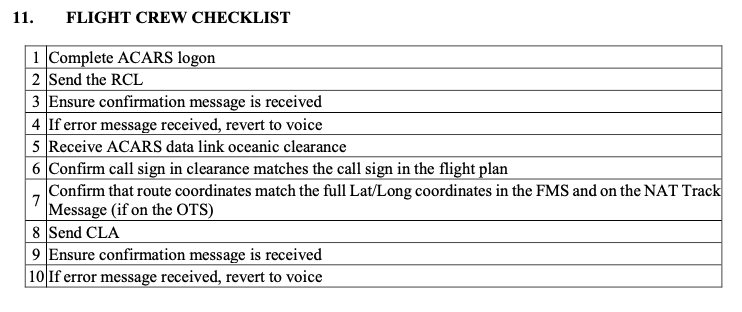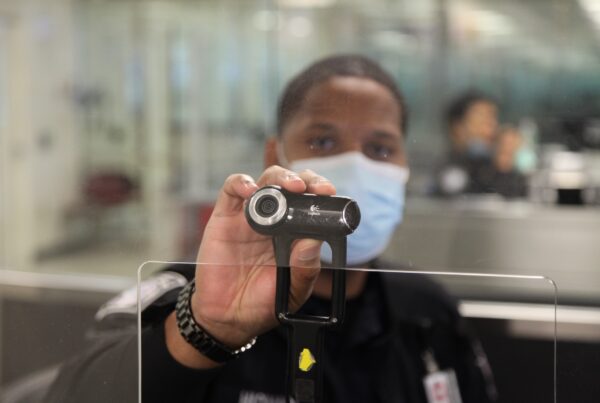There is a revised NAT OPS Bulletin that was issued June 14. Bulletin 2020_001 is all about ACARS Data Link Oceanic Clearances.
It puts all the procedures for CZQX/Gander, BIRD/Reykjavik, ENOB/Bodø, EGGX/Shanwick and LPPO/Santa Maria into one spot, instead of having them spread between all the different individual ANSP NAT OPS Bulletins.
When we compared the old version of the Bulletin with this new one there aren’t really any big differences at all. Essentially none, in fact. But since we recently confused ourselves a lot over all things ACARS related, here is a refresher summary of what it says…
Have a read of the intro first
Point 2.2 of the introduction says this:
“The ACARS Data link oceanic clearance service is provided by means of VHF and satellite to ACARS equipped aircraft via communications service providers ARINC and SITA. It should not be confused with FANS 1/A CPDLC.”
(I totally confused these earlier, despite having used both.)
“Operators intending to participate in the ACARS data link process are required to contact their communications service provider and indicate they would like to receive the service.”
So that means the likes of ARINC and SITA.
The Procedures (in short)
1. Put the ACARS logon in, along with your flight number and the OCA facility.
2. Make sure you request your clearance at the right time (not too early, not too late). Here is the current table of timings:

Not too soon, not too late, or rule of thumb…
(This is the only change we spotted from the old one – Gander used to say 90-30 minutes, now it says 90-60 minutes.)
3. Make sure your RCL has all the right stuff in it:
- The OEP (this means Oceanic Entry Point, not to be confused with OAPs which mean old person)
- Your ETA for the OEP
- The requested flight level
- The highest acceptable flight level you could reach by the OEP. This goes in the free text section by putting MAX F123
4. If you don’t get some sort of “RCL Received” message within 5 minutes of sending it then you’re going to have to use voice instead.
5. Once you get your clearance, check it well. That means checking the LATs and LONGs in your FMC. If the clearance doesn’t match your flight plan, then both pilots should independently confirm the coordinates and points. If you don’t like your clearance then negotiate by voice, otherwise send your CLA (clearance acknowledgement). If you don’t have that function, do it with your mouth.
Some peculiarities with each of the OCAs
Gander
- If you’re departing somewhere less than 45 minutes from your Gander OEP, then get your clearance 10 minutes before you depart.
- Sometimes you might get an ACARS oceanic clearance before you’ve even sent the RCL.
- If you fly an aircraft that is not able to send an RCL, then you can set yourself up for Gander’s special service but need to do it in advance:
- Get in touch with your comms service provider and NavCanada
- Put AGCS in item 18 of your flight plan
- Expect to receive your clearance automatically once you logon
Shanwick
- You must not enter Shanwick without a clearance.
- If you’re flying between and Irish and a Scottish airport, its not very far, so might want to get your clearance before departure.
- You get 2 chances with Shanwick. If at first you don’t succeed (you don’t get the RCL received confirmation) then try again.
- If you’ve left it too late and are within 15 minutes of your OEP, you ain’t going to get your clearance via ACARS.
Reykjavik
- They don’t give clearances via ACARS if you’re departing from an airport in Iceland, Greenland or the Faroe Islands. Get it from whoever you’re talking to on the ground before you go.
Santa Maria
- You don’t need an RCL if you’re departing from the Azores, you’ll get it through the (VHF) radio or possibly get a CPDLC route confirmation before you head out into the great blue yonder.
Other helpful stuff in the bulletin
Gander: Robert Fleming robert.fleming@navcanada.ca
Reykjavik: Bjarni K. Stefansson bjarni.stefansson@isavia.is
Bodo: Kenneth Berg Kenneth.volden.berg@avinor.no
Shanwick: Iain Brown iain.brown@nats.co.uk
Santa Maria: Jose Cabral jose.cabral@nav.pt
More on the topic:
- More: What’s Changing on the North Atlantic
- More: Timeline of North Atlantic Changes
- More: Spoofed Before the NAT? Here’s What to Do
- More: Shanwick Delays OCR Until Post-Summer 2026
- More: Blue Spruce Routes Are Gone (But You Can Still Fly Them)
More reading:
- Latest: More face scans at the US border: BizAv now included
- Latest: Mexico Customs Surprises: Pills, Vapes, and Laptop Rules
- Latest: Greenland NAT Alternates: Dec 2025 Update
- Safe Airspace: Risk Database
- Weekly Ops Bulletin: Subscribe
- Membership plans: Why join OPSGROUP?












 Get the famous weekly
Get the famous weekly 






If you’re flying between and Irish and a Scottish airport, its not very far, so might want to get your clearance before departure.
Did you mean “entering the NAT area from a Scottish or Irish airport”?
A couple of weeks ago there was talk about a “whitelist” for Oceanic ACARS clearances with Shanwick. Do operators still need to register for that service?
Hi Kevin – My understanding is that if you use a callsign you’ll have to register it directly with Shanwick, otherwise you will get the ACARS clearance message but you will see the text “CONFIRM BY VOICE” at the end. If you don’t use a call sign and file with the aircraft registration instead, the two-character IATA code used by your ACARS provider and configured in the aircraft avionics is used instead and the clearance process should function normally (without the voice readback requirement) . I work for Satcom Direct supporting our flightdeck services including ACARS but I know the other service providers for GA are doing the same so you should be good.
Hi guys,
nice article! Thanks!
Do u also happen to have a NY contact?
Cheers,
Pat
Hello Rebecca,
“You definitely shouldn’t enter Shanwick without a clearance” do you know the reason (and the reference) for this Shanwick peculiarity ?
Best Regards and thanks for support
Hi Davide, Shanwick have always been stricter on the clearance side of things, HF requirements etc. The reference for that particular statement is straight out of the (linked) NAT OPS Bulletin (section 4 ‘Requesting a clearance’) and presumably is within the related AIP as well.
Don’t enter Shanwick without a clearance: I know not to do it, but I can’t for the life of me find anything written about what to do without the clearance when only in HF. If I’m VHF and radar with Shannon, it’s easy enough to work a plan with them. But what if I’m non-radar HF with Gander. Enter a hold? That seems bad, especially on a track. Call Gander and ask for instructions while I go flying into Shanwick’s airspace like I’m not supposed to do? What’s a good contingency plan for no contact with Shanwick?
Hi Dave, The likelihood of reaching the Shanwick boundary without receiving a clearance is pretty remote. If you’re heading into the NAT HLA via Shanwick and cannot get a clearance then you’d presumably try all other radio and comms options. Failing all of it, you’d need to divert/ not enter but in that direction you’ll likely be in contact with someone, unless you’ve suffered an entire loss of comms. If you’re in Gander (in the NAT HLA) you’d already have a clearance so a loss of comms (or HF) would mean continuing as cleared.
Bec’s view is practical.
This is my take for those keen to find references…
The original concern of ‘No clearance’ was when there was very limited surveillance and limited automation within domestic and oceanic ATC. The density of westbound traffic and lack of clearance by an aircraft may possibly compromise separation requirements after entry.
The NAT 007 from 2018 clearly states a requirement to contact domestic ATC and remain clear of oceanic airspace (5.1.10). The most recent version (2022) just advises crew to follow appropriate procedure stipulated in the AIP.
UK AIP ENR 2.2 ( 3.7.2) reference repeats the earlier NAT 007 and adds that it is the pilots’ responsibility to remain clear of oceanic airspace!
Remember this rule applies to westbound traffic.